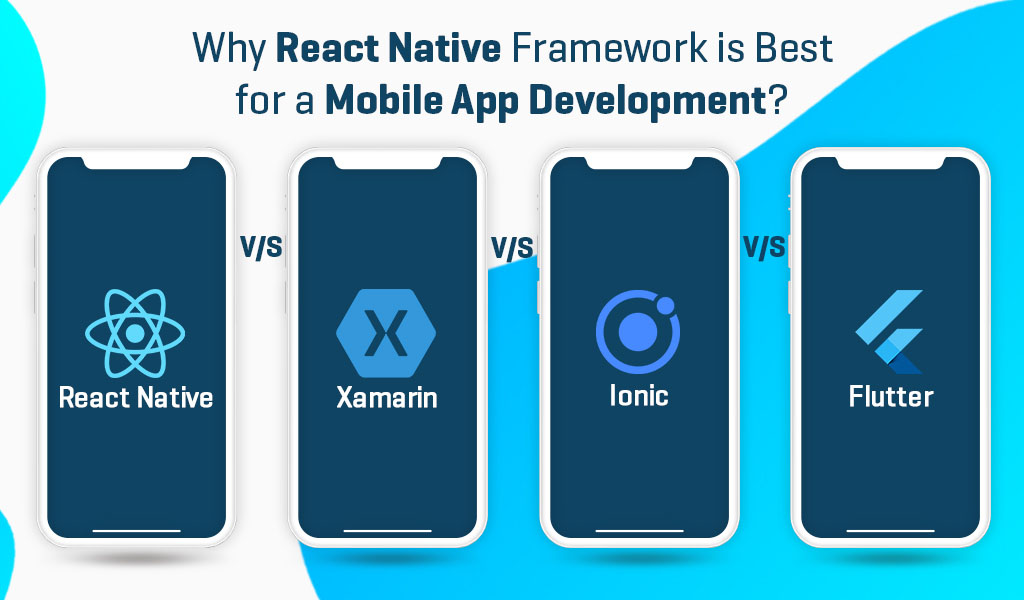
While developing Native Mobile Apps, thee code is written in Java for Android app and iOS ones in Swift / Objective-C. No doubt, this approach delivers apps that are flawless in performance. But, the development path with this perspective is time-consuming and very expensive. So, what is the solution to get things done in a seamless way without investing a lot of coding time and a lot of money? The answer is Cross-platform Mobile App Development.
There are multiple Cross Platform app Development framework like React Native (Facebook), Xamarin (Microsoft), Flutter (Google) and Ionic. There are Pros and Cons of each and one should decide which one is best and save time& money for Cross-Platform Mobile App Development.
1. Graphical User Interface(GUI):
Users judge apps within few second of first-time usage and that’s why the GUI of an app must be engaging while being easy – let’s see what this framework offers:
React Native:
React Native modules associate with native UI controllers, it gives amazing user experience that is very close to mobile native apps. It utilizes the ReactJS library with extensive UI elements and streamlines the UI development.
Xamarin:
It enables you to make the UI in two different ways: utilizing Xamarin.Android/iOS or Xamarin forms. The first option is very time consuming, but guarantees a native look and feel in terms of UX. With Xamarin Forms you can make the development process significantly fast and it frees up lot of resources but at the cost of a local look. It can be a good solution for internal and corporate ventures, where the UI part isn’t as essential as in customer applications.
Ionic:
Ionic UI doesn’t utilize native elements it renders everything in HTML and CSS. Then it applies Cordova to give native mobile experience. Angular components of the framework also enable Ionic apps to look like native ones.
Flutter:
Flutter provides the best GUI. No doubt Ionic and Xamarin give us cross-platform apps but their efficiency and performance cannot beat Flutter and React Native. They lack in responsiveness if the app is heavy and more native UI components are used.
2. Performance:
This attribute is the most important – how do the apps made in different frameworks perform from a run-time perspective?
React Native:
The performance it provides is very same to native applications as it renders code elements specifically to the native APIs. React additionally allow us to use native modules written in native languages to write code for complicated operations. However, they can’t be reused across two platforms; their main aim is to provide higher performance.
Xamarin:
Xamarin performance is also considered as being close to native. Xamarin has two ways to build mobile applications and that is Xamarin.Android/Xamarin.iOS and Xamarin.Forms. It helps the native performance that isn’t possible with solutions that interpret code at runtime. This altogether decreases code performance in numerous operations compared to different platforms.
Ionic:
In terms of performance, this approach significantly decreases the speed. Also, ionic app development doesn’t use native components to create a native look and feel by using web technologies. The upside of Ionic is its quick testing process that runs instantly in a browser that streamlines the development process.
Flutter:
When compared on the basis of app performance, it is the Flutter that takes the crown over its competitors. There is no JavaScript bridge for starting interactions with the device native components, the speed it offers is amazing.
3. Code Reusability:
You will get an idea of how much of the code you write can be re-used for both platforms which is the main purpose of these frameworks.
React Native:
React native framework uses native components written in Objective-C, Swift, or Java to enhance the app performance. White React code can be reused, you can’t reuse native components over other platforms. So, developers need to do the same little work for changing this particular codebase. However, accept these native components whatever is left of the codebase can be re-used.
Xamarin:
It doesn’t require switching between the developments environments all Xamarin framework are developed in Visual Studio. Usually, up to all most of the source code can be reused with Xamarin.Forms that speeds up the development process.
Ionic:
Whatever the OS gave, they will work similarly well on every one of them. But, some UI components need to be changed to the rules by a particular platform, which will require extra efforts.
Flutter:
In react Native, we have ready-to-use functions, which speed-up the speed of development. However, in Flutter, we need to add dedicated files for both of platform depending upon their rules
4. Security:
React Native is a JavaScript library and open-source framework, which creates a gap in the security robustness. But at times, you need to provide extra security specifically if you are creating banking and financial apps where data is highly confidential.
Xamarin:
Xamarin, you can be assured of the app and data security. As the connections between different app components are hosted on the Azure cloud and are encrypted, your app is secure
Ionic:
Ionic lets application developers implement dynamic access controls with just a few lines of code, providing a consistent, seamless way to enforce authorization policies that govern the security of your applications, resources, services, and workloads.
Flutter:
Flutter provides developers with secure and trusted authentication plugins which allow you to integrate sign-in and social features into your app. To secure your app’s authentication, only use these officially sanctioned plugins instead of handling authentication yourself.
5. The Language support:
Let’s see which the best framework is utilizes which programming languages and offer what benefits:
React Native:
It utilizes JavaScript which is at present one of the most powerful, dynamic, and very high-level programming languages. It combines of the JavaScript and React.JS and is sponsored by Facebook. React native development services that makes it best among the other three frameworks in terms of a Programming language is that it allows writing a few components in Swift, Objective-C, or Java when developers require them. Utilizing libraries to React to Native applications, you can manage computationally heavy operations like video handling or image editing, mapping, etc…
Xamarin:
c# environment to develop Android, iOS, and Mac applications. Anything that can be with native languages, a developer can do in C# utilizing Xamarin. However, developers can’t utilize native open-source libraries accessible for iOS and Android with these tools, there is a variety of .net libraries accessible that fills the coveted need.
IONIC:
It uses HTML5, CSS, and JS to develop and run applications, and requires Cordova wrapper to access native Cross platform controllers. Also, use of Type Script improves the feature of the code.
Flutter:
Dart to develop high-quality applications for Android, iOS, and the web. Dart is an amazing Programming language that offers benefits and is based on C/C++ and java. Despite being new, the language is soon expected to take the industry by storm.
6. Pricing:
React Native :
It is completely open-source frameworks. also, utilize these systems and their libraries for free.
Xamarin:
Xamarin requires developers to install an Integrated Development Environment (IDE), it is provided on a subscription basis.
Ionic:
It is a free open source framework for developing cross-platform mobile applications. But, the organization offers its Pro version which is paid. The same company guarantees that Ionic Pro the development process.
Flutter:
Flutter is completely open-source framework. Also, utilize these systems and their libraries for free.
For Cross-Platform Mobile App Development all the four frameworks have gained reliability among organizations aiming to decrease the time and expenses of app development. Each of the four frameworks can be useful, depending upon your priorities and business needs.
But React native and Flutter Standout with their ease with coding, performance and Developer community support.







